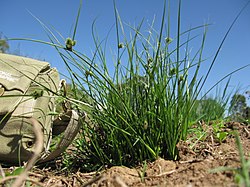Biology:Carex inversa
| Knob sedge | |
|---|---|

| |
| Scientific classification | |
| Kingdom: | Plantae |
| Clade: | Tracheophytes |
| Clade: | Angiosperms |
| Clade: | Monocots |
| Clade: | Commelinids |
| Order: | Poales |
| Family: | Cyperaceae |
| Genus: | Carex |
| Species: | C. inversa
|
| Binomial name | |
| Carex inversa R.Br., 1810
| |
Carex inversa, commonly known as knob sedge, is a species of sedge of the family Cyperaceae that is native to parts of Australia [1] and New Zealand and has also been introduced into Great Britain.[2]
Description
The monoecious and rhizomatous perennial grass-like sedge has a tufted habit and typically grows to a height of 0.3 to 0.75 metres (1 to 2 ft). It blooms between September and October producing brown flowers.[1] The plant has a reasonably long rhizome with shoots that are loosely tufted. The smooth and erect culms have a circular cross-section and are usually 10 to 50 cm (3.9 to 19.7 in) in length. The length of the leaves is usually less than that of the culms and have a blade with a width of 0.7 to 2 mm (0.028 to 0.079 in) and are surrounded by dark brown coloured sheaths.[3]
Taxonomy
The species was described by Robert Brown in 1810 as a part of the work Prodromus Florae Novae Hollandiae et Insulae Van Diemen[2] from specimens collected from his time in Australia between 1801 and 1806. There are ten synonyms for this species including; Carex inversa var. leichardtii, Carex inversa var. major, Carex inversa var. minor, Carex rhytidocarpa and Vignea inversa.[2]
Distribution
It is native to parts of Australia, and is often found in winter wet depressions and along creek and rivers throughout a large area through the Wheatbelt, Peel, South West and Great Southern regions of Western Australia where it grows in sandy-clay-loam soils.[1] It is also found in south eastern parts of South Australia and southern and eastern parts of Australia extending north into coastal areas of New South Wales and Queensland.[4] The grass also occurs on Norfolk Island.[5] The plant is also commonly found in New Zealand and is regarded as non endemic.[6]
See also
References
- ↑ 1.0 1.1 1.2 "Carex inversa". FloraBase. Western Australian Government Department of Parks and Wildlife. https://florabase.dpaw.wa.gov.au/browse/profile/756.
- ↑ 2.0 2.1 2.2 "Carex inversa R.Br.". Kew Science – Plants of the World Online. https://powo.science.kew.org/taxon/urn%3Alsid%3Aipni.org%3Anames%3A300341-1.
- ↑ "Carex inversa R.Br.". PlantNet. Royal Botanic Garden, Sydney. https://plantnet.rbgsyd.nsw.gov.au/cgi-bin/NSWfl.pl?page=nswfl&lvl=sp&name=Carex~inversa. Retrieved 3 August 2022.
- ↑ "Carex inversa". Electronic Flora of South Australia species Fact Sheet. Government of South Australia. http://www.flora.sa.gov.au/cgi-bin/speciesfacts_display.cgi?form=speciesfacts&name=Carex_inversa. Retrieved 2 August 2022.
- ↑ "Knob Sedge -native (Carex inversa)". Plants of the Castlemaine District. Castlemaine Flora. 2018. https://www.castlemaineflora.org.au/pic/c/carex/cainv.htm. Retrieved 3 August 2022.
- ↑ "Carex inversa R.Br.". New Zealand Organisms Register. https://www.nzor.org.nz/names/322322b8-f538-4441-be78-9a527fdab8ec. Retrieved 3 August 2022.
Wikidata ☰ Q2938529 entry
 |

